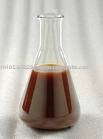
|

We are the manufacturer of soya lecthin food grade and animal feed. We are one of the biggest manufacturer in central india.
COMPOSITION
Soy Lecithin consists of three types of phospholipids; phosphatidylcholine (PC),
phosphatidylethanolamine (PE) and phosphotidylinositol (PI). It is extracted from
soybean oil and is generally used as a natural emulsifier or stabilizer in various food
applications.
PROCESSING
Lecithin is a combination of naturally-occurring phospholipids, which are extracted
during the processing of soybean oil. The soybeans are tempered by keeping them at a
consistent temperature and moisture level for approximately seven to 10 days. This
process hydrates the soybeans and loosens the hull. The soybeans are then cleaned and
cracked into small pieces and the hulls are separated from the cracked beans. Next, the
soybean pieces are heated and pressed into flakes. Soybean oil is extracted from the
flakes through a distillation process and lecithin is separated from the oil by the addition
of water and centrifugation or steam precipitation1
.
FUNCTIONAL BENEFITS
Lecithin is utilized in a wide variety of food and industrial applications. The French
scientist, Maurice Gobley, first discovered the substance in 1850, and named it
"lekithos," the Greek term for egg yolk. At the time, eggs provided a primary source of
commercially-produced lecithin. Today, the majority of lecithin used in food applications
is derived from soybeans.
Soy lecithin offers a multifunctional, flexible and versatile tool. It is probably best known
for its emulsifying properties, which help promote solidity in margarine and give
consistent texture to dressings and other creamy products. Lecithin is also used in
chocolates and coatings and to counteract spattering during frying. Additionally, its
unique lipid molecular structure makes lecithin useful for pharmaceutical and cosmetic
applications and various industrial uses such as paints, textiles, lubricants and waxes.
HEALTH BENEFITS & CLAIMS
Lecithin provides an excellent source of choline, which is essential to every living cell in
the body and is one of the main components of cell membranes. Not only is dietary
choline important for the synthesis of the phospholipids in cell membranes, it is also
necessary for
methyl metabolism, cholinergic neurotransmission, transmembrane
signaling, and lipid-cholesterol transport and metabolism2
. Without choline, the cell
membranes would harden, prohibiting important nutrients from entering and leaving the
cell. Scientists believe lecithin and choline may aid in memory and cognitive function,
cardiovascular health, liver function, reproduction and fetal development and physical
and athletic performance.
In 1998, the Institute of Medicine (IOM) of the U.S. National Academy of
Sciences
identified choline as an essential nutrient and recommended daily intake amounts
3
. And,
in 2001, the U.S. Food and Drug Administration (FDA) approved a nutrient content claim
for choline, enabling food manufacturers to inform their consumers via the food label. Foods that contain over 110 mg of choline per serving may claim that they are an
"excellent source of choline" and those with over 55 mg may claim that they offer a
"good source of choline
4
."
ALLERGENICITY
The allergens in soybeans reside in the protein fraction of the bean. The allergenic
potential of specific soyfoods and/or ingredients is largely based on processing
techniques and the amount of protein or protein residue remaining in the final product
5
.
The majority of soy lecithin used in food applications is derived from Refined Soybean Oil
that has been processed using the hot-solvent extraction technique, which eliminates
most, if not all, allergenic proteins.
In 1998, Awazuhara et al published a study on the antigenicity of the residual proteins in
soy lecithin and soybean oil, in which they tested soybean-sensitive individuals for
reactions to soybean oil and soy lecithin. Researchers investigated the IgE- and IgG4-
binding abilities of the soy lecithin and concluded that the proteins in soy lecithin have
little antigenicity in regard to soybean allergy6
.
Although limited data exist on the allergenicity of soy lecithin, Steve Taylor, PhD, head
of the Department of Food Science and Technology at the University of Nebraska and co-
director of the Food Allergy Research Resources Program, concludes that, avoidance is
probably unnecessary for most soy-allergic individuals
7
.
CONCLUSION
Soys healthy image extends beyond soyfoods and carries over to byproducts of the bean
itself, such as soybean oil and lecithin. The discovery of specific health benefits
continues, making soy a welcome sight on ingredient labels. Not only does soy present a
potential marketing advantage, but the abundant supply of soybeans guarantees that
ingredients such as lecithin are readily available and cost effective.
| Type: Emulsifiers | Color: Brown |